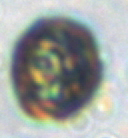Last week I visited Melissa Omand’s lab at the University of Rhode Island to analyze sediment trap samples collected on the R/V Endeavor. Unfortunately I was not able to go on the cruise, but I was still lucky enough to look at the exciting samples they brought back.

The types of samples collected on this cruise were very similar to those we collected in November. Sediment traps collected sinking particles in the water column. Above you can see how the number of sinking particles decreased with depth. These are images of the polyacrylamide gel jars placed in the bottom of traps at 4 depths spanning the upper mesopelagic zone. The 60 meter trap was full of zooplankton fecal pellets (the long stringy particles). At 150 meters, fluffy diatom aggregates appeared (mostly containing Pseudo-nitzschia), but sinking fecal pellets were also still abundant. At high magnification, it became apparent that the traps were also chock-full of tiny little particle which turned out to be individual sinking coccolithophore cells. They are only about 10 micrometers big, and difficult to image clearly, but you can just make out the circular coccolith plates covering the outside of this cell .
Although there is still much analysis to be done, these first observations are already exciting and represent a very different particle export environment than what we observed last November, which was dominated by large organic aggregates and large diatom cells.
On a related note, the URI Inner Space Center created several short videos about the research cruise last November. Here are the films explaining the sediment traps.
Meg Estapa explaining the neutrally buoyant sediment traps:
Me, explaining the particle work:
Pat Kelly explaining the surface-tethered sediment trap array and in-situ pumps:


